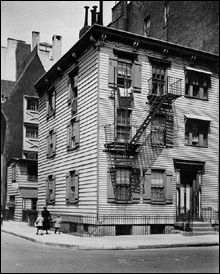Grove Street
 So, here was my neighborhood; quite undeserving of such tawdry acts. Here's a mini-travelogue I assembled from different historian's articles.
So, here was my neighborhood; quite undeserving of such tawdry acts. Here's a mini-travelogue I assembled from different historian's articles.This house, at 17 Grove, was my view when I looked out the window. Turns out it was quite famous:
It was built for window-sash maker William Hyde in 1822, the year that an outbreak of yellow fever led many New Yorkers to seek the safety of rural Greenwich Village.It's the most complete wooden frame house in Greenwich Village; the largest and most intact of the Village's remaining wood-frame structures, (which were outlawed for fire prevention in 1866.)
Originally of two stories, the house gained a third floor in 1870. The sash maker's workshop, visible behind the house on Bedford Street, became a single-family residence.

In 1987, 17 Grove Street was purchased for $1.1 million and meticulously restored, a quintessential example of contemporary gentrification. The building has since served many functions -- most interesting of which was as a brothel during the Civil War.
So maybe it was an appropriate neighborhood for that callboy and his johns.
Behind it sits a mock Victorian "castle" (named "Twin Peaks") at 102 Bedford Street. This was designed in 1925 by amateur architect Clifford Reed Daily. Supported (ahem) by opera impresario and art patron Otto Kahn, Daily embodied the stereotype of the Greenwich Village "eccentric" and set out to create a home appropriate to "the minds of creative Villagers."
The New York Herald Tribune reported that Kahn had met Daily in the Little House tea room and had adopted Daily's idea for a building of 10 one-room apartments for artists. Daily, unmarried, lived in an old house on Sheridan Square, and gave his occupation as builder...
(watercolor by Danny Gregory)
On May 21, 1926, the Tribune reported that the actress Mabel Normand stood on a platform on top of one of the gables and shattered a bottle of Champagne over the roof. Next to her, Princess Amelie Troubetskoy (an American novelist who had married a Russian prince in czarist days) burned acorns in a charcoal brazier in honor of the Greek god Pan. Holy water, flowers and other rites also inaugurated the building.
Yeah, yeah, Mabel, I used to do that, too, on lonely Saturday nights.
Around my corner, at 86 Bedford, sits Chumley's, a former speakeasy that still has no sign. It was a literary hangout for Steinbeck, Fitzgerald, O’Neill, Dos Passos, Faulkner, Anais Nin, Orson Welles, Edna St. Vincent Millay, and James Thurber. It was the kind of place where you'd say "Joe sent me," and they'd pass you in. So people got passed in, and then passed out.
Living at 36 Grove, one of the Greek Revival/Italianate townhouses built in 1851, was Emma Goldman. She was living there when she was deported to the Soviet Union during the 1919 Red Scare.She was played, in an Oscar-winning performance, by Maureen Stapleton in the movie "Reds." Coincidentally, up the street at #45, was a Federal-style manor house -- also used in the movie -- as residence of Eugene O'Neill.
Said to be the last of its kind in the neighborhood, John Wilkes Booth plotted the Lincoln assassination with co-conspirators there.
Communists, assassins, they all loved the old neighboorhood.
In 1923, poet Hart Crane lived there when he wrote "The Bridge", his paean to New York. Shortly thereafter, he threw himself out of a boat and died.
The curse of tragedy in the water carries on to this day; the house now sits over a laundromat.



1 Comments:
Looks nice! Awesome content. Good job guys.
»
Post a Comment
<< Home